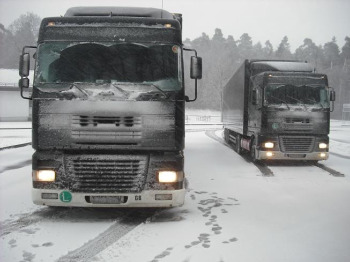When thinking of travel, one thinks of buses and trains, planes and even bicycles, but rarely – I suspect – of trucks. Yet, from four-wheel removal vehicles to eighteen-wheel juggernauts, they are synonymous with travel. The diesel engine ignites; the wheels begin to turn. The truck and driver are off on an adventure. That legendary allure of the open road may have rapidly declined with modern day traffic, but unknown roads, and even unfamiliar countries, still beckon.

Ever pondered the logistics of rock and roll concerts? Planes and ships may play their part on occasion, but – predominantly – the vehicles used are trucks. Depending on show size, there can anywhere from a lone 7.5-ton truck to fifty-four eighteen-wheelers (on U2’s 360 Degree Tour). But who are the unsung heroes that pilot them? Without the drivers, bands would look a little foolish standing in the dark without lights, sound and their instruments.
The drivers hail from all walks of life, and are both male and female. Women, however, are very much in the minority – through choice, rather than any physical hardship involved in truck driving. Some drivers are gregarious, others aloof. Some began as guitarists or drummers, or are die-hard rock fans; others simply enjoy driving, or are interested in exploring foreign cities.
The beauty for the latter group is the access to new cities that entertainment trucking offers. The venues visited are either in city centres, (club gigs, theatres) or within easy public transport of a city centre (arenas and stadiums). While general haulage drivers traipse speedily back and forth between say, Italy and UK – admiring the en-route vista of Mont Blanc, Western Europe’s highest mountain – rock and roll truckers succumb to a different pace.
When Bono plays in Dublin for three nights, what do the crew truckers do with their paid time off? Well, apart from drink Irish whiskey – as opposed to whisky, which is Scottish – they have the opportunity to travel. Some will take a bus tour; others may unload bicycles from their trailers and visit the Trinity Library with its infamous Book of Kells, written in the ninth century. Some will plod along the banks of the Liffey to the Guinness factory; others will dine romantically with spouses who have flown over for the weekend. Either way, it sounds idyllic, no? Well…
Remember how relieved you were to return home after a two-week holiday? Well, try going away for six months. Last year, tour truckers leapfrogged straight from AC/DC’s Black Ice World Tour (finishing in Glasgow) to the U2 tour beginning in Barcelona. There was no gap to visit families, wives or girlfriends. The other big fly in the ointment is that driving is chiefly carried out in the hours of darkness, which plays havoc with booking hotels. Consequently, drivers doze fitfully in their cabs in punishing summer temperatures, sweating and swatting mosquitoes. It certainly isn’t all glamour.
Smaller tours (one or two trucks) can be gruelling. Tour dates can be consecutive nights in cities several hundred miles apart: Paris-Frankfurt-Munich-Prague-Vienna-Budapest etc. Bigger tours (Paul McCartney, Rolling Stones) can involve Herculean journeys from say, Czech Republic to Norway, but then there is often time to explore a city’s attractions for a day or two upon arrival.
Simply driving between cities, though, can be an adventure in itself. Driving to beautiful Bergen on Norway’s coast may yield Northern Lights on a winter’s night. Or there is the intrigue of boarding a ferry from one of Germany’s Baltic ports, bound for St. Petersburg, one of the world’s most beautiful cities. Or driving into Cagliari on the island of Sardinia, wondering whether the Roman amphitheatre – Lou Reed performed there – can accommodate articulated trucks instead of chariots. It can’t!
There is always a sense of moving while on tour. Often it can be frustrating to visit a city when under restrictive time constraints. The driver has to unload in the morning, get some sleep, reload and drive again at night. Spending just two hours in say, the Louvre Museum in Paris – it will take you those two hours simply to find the Mona Lisa and exit again – is almost too heart-breaking to contemplate. It may take two or three visits to a city before you get any real time off to sightsee. But then there are the staging drivers.
Staging, or “steel,” drivers haul the stage around. However, regardless of distance between shows, there is no way of hastily erecting a stage in the space of a morning. Even a bog-standard stage – carried on around fifteen flat-deck trailers – takes a couple of days to rig. So how do the tours work, when Madonna is performing in Rome and then in London a couple of nights later? More than one stage is used. In fact, summer stadium tours almost always use three stages.
Staging could arguably be regarded as the dream trucking job. Drivers spend almost a week at every third show of a tour, twiddling their thumbs until it is time to drive once more. There is no choice of destination though: for five days, they could be gorging on paella in Valencia, or pintos (tapas) in the Basque region of Spain, or trying to translate a Polish menu in Warsaw. But isn’t unfamiliarity the attraction of travel?
Next time you see a truck clogging up the road, don’t regard him as a road hog. Consider where he might be going, and when he’ll next return home. He’s a traveller too, you know.
all photos by Barnaby Davies & may not be used without permission